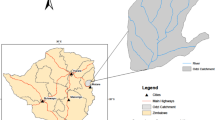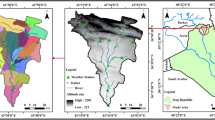Abstract
The Water Erosion Prediction Project (WEPP) model is utilized to simulate the sediment and runoff processes. According to previous studies, WEPP model provides impressive results in watersheds of diverse climates and scales. It is also capable of modeling the sediment transportation processes and consequently predicting subsequent deposition sites. In this study, the geo-spatial interface for WEPP (GeoWEPP) was employed as a GIS framework to extract the data required from the ASTER Global Digital Elevation Model (ASTER-GDEM) dataset which was subsequently used as the model input. The case study was based on monthly data consisting of average sediment and runoff estimation from the Emameh sub-basin, in northern Iran. The model estimations were validated through field measurements. Two statistical measures of co-efficiency including the Nash–Sutcliffe Efficiency (NSE), and the coefficient of determination (R 2) were considered to evaluate how well the model predictions could explain the variability of observations in the field. The model performed favorably as corroborated by a reasonably high NSE of 0.99 and an R 2 value of 0.92 for sediment. In the case of runoff, the results were slightly inferior, but still acceptable with an NSE of 0.76 and R 2 value of 0.62.








Similar content being viewed by others
References
Adhikary PP, Tiwari S, Mandal D, Lakaria BL, Madhu M (2014) Geospatial comparison of four models to predict soil erodibility in a semi-arid region of Central India. Environ Earth Sci 72:5049–5062
Akbari A, Abu Samah A, Othman F (2012) Integration of SRTM and TRMM date into the GIS-based hydrological model for the purpose of flood modelling. Hydrol Earth Syst Sci Discuss 9:4747–4775
Amore E, Modica C, Nearing MA, Santoro VC (2004) Scale effect in USLE and WEPP application for soil erosion computation from three Sicilian basins. J Hydrol 293:100–114
Baigorria GA, Romero CC (2007) Assessment of erosion hotspots in a watershed: integrating the WEPP model and GIS in a case study in the Peruvian Andes. Environ Model Softw 22:1175–1183
Bathrellos GD, Gaki-Papanastassiou K, Skilodimou HD, Papanastassiou D, Chousianitis KG (2012) Potential suitability for urban planning and industry development by using natural hazard maps and geological–geomorphological parameters. Environ Earth Sci 66(2):537–548
Bathrellos GD, Gaki-Papanastassiou K, Skilodimou HD, Skianis GA, Chousianitis KG (2013) Assessment of rural community and agricultural development using geomorphological–geological factors and GIS in the Trikala prefecture (Central Greece). Stoch Environ Res Risk Assess 27(2):573–588
Bhuyan SJ, Kalita PK, Janssen KA, Barnes PL (2002) Soil loss predictions with three erosion simulation models. Environ Model Softw 17:135–144
Chousianitis K, Del Gaudio V, Kalogeras I, Ganas A (2014) Predictive model of Arias intensity and New mark displacement for regional scale evaluation of earthquake-induced landslide hazard in Greece. Soil Dyn Earthq Eng 65:11–29
Daly C, Neilson RP, Phillips DL (1994) A statistical topographic model for mapping climatological precipitation over mountainous terrain. J Appl Meteorol 33:140–158
Defersha MB, Melesse AM (2012) Field-scale investigation of the effect of landuse on sediment yield and runoff using runoff plot data and models in the Mara River basin, Kenya. Catena 89:54–64
Defersha MB, Melesse AM, McClain ME (2012) Watershed scale application of WEPP and EROSION 3D models for assessment of potential sediment source areas and runoff flux in the Mara River Basin, Kenya. Catena 95:63–72
Ella VB (2005) Simulating soil erosion and sediment yield in small upland watersheds using the WEPP model. In: Coxhead I, Shively GE (eds) Landuse change in tropical watersheds: evidence, causes and remedies. CABI Publishing, CAB International, Oxford shire
Ellison WD (1944) Studies of raindrop erosion. Agric Eng 25:131–136
Flanagan D, Nearing M (1995) USDA-water erosion prediction project: hillslope profile and watershed model documentation. NSERL Report No. 10. USDA-ARS National Erosion Research Laboratory, Indiana
Flanagan DC, Gilley JE, Franti TG (2007) Water Erosion Prediction Project (WEPP): development history, model capabilities, and future enhancements. Trans ASABE 50(5):1603–1612
Foster GR, Lane LJ (1987) User requirements: USDA Water Erosion Prediction Project (WEPP). NSERL Laboratory. USDA-ARS National Soil Erosion Research, West Lafayette
JSS (2012) ASTER GDEM Version 2 (Online). http://gdem.ersdac.jspacesystems.or.jp/. Accessed May 2012
Julien PY (2010) Erosion and sedimentation. Cambridge University Press, UK
Magliulo P (2012) Assessing the susceptibility to water-induced soil erosion using a geomorphological, bivariate statistics-based approach. Environ Earth Sci 67:1801–1820
Mahmoodabadi M, Cerdà A (2013) WEPP calibration for improved predictions of interrill erosion in semi-arid to arid environments. Geoderma 204:75–83
Mhangara P, Kakembo V, Lim KJ (2012) Soil erosion risk assessment of the Keiskamma catchment, South Africa using GIS and remote sensing. Environ Earth Sci 65(7):2087–2102
Min Y-M, Kryjov VN, An K-H, Hameed SN, Sohn S-J, Lee W-J, Oh J-H (2011) Evaluation of the weather generator CLIGEN with daily precipitation characteristics in Korea. Asia-Pac J Atmospheric Sci 47:255–263
Minkowski M, Renschler C (2012) GeoWEPP for ArcGIS 9.x Full Version Manual. Department of Geography State University of New York at Buffalo
Nahvi H (1994) Estimation of CN in Emmameh Watershed. Master Degree, University Of Tehran
Nash JE, Sutcliffe JV (1970) River flow forecasting through conceptual models part I—a discussion of principles. J Hydrol 10:282–290
Pandey A, Chowdary V, Mal B, Billib M (2008) Runoff and sediment yield modeling from a small agricultural watershed in India using the WEPP model. J Hydrol 348:305–319
Papadopoulou-Vrynioti K, Bathrellos GD, Skilodimou HD, Kaviris G, Makropoulos K (2013) Karst collapse susceptibility mapping considering peak ground acceleration in a rapidly growing urban area. Eng Geol 158:77–88
Refahi H (1996) Water erosion and control. University of Tehran, Tehran
Rozos D, Bathrellos G, Skillodimou H (2013a) Comparison of the implementation of rock engineering system and analytic hierarchy process methods, upon landslide susceptibility mapping, using GIS: a case study from the Eastern Achaia County of Peloponnesus, Greece. Environ Earth Sci 63:49–63
Rozos D, Skilodimou HD, Loupasakis C, Bathrellos GD (2013b) Application of the revised universal soil loss equation model on landslide prevention. An example from N. Euboea (Evia) Island, Greece. Environ Earth Sci 70(7):3255–3266
Shen Z, Gong Y, Li Y, Hong Q, Xu L, Liu R (2009) A comparison of WEPP and SWAT for modeling soil erosion of the Zhangjiachong Watershed in the Three Gorges Reservoir Area. Agric Water Manag 96:1435–1442
Singh R, Panda R, Satapathy K, Ngachan S (2011) Simulation of runoff and sediment yield from a hilly watershed in the eastern Himalaya, India using the WEPP model. J Hydrol 405:261–276
Sparovek G, Bacchi O, Schnug E, de Ranieri S, Maria I (2000) Comparison of three water erosion prediction methods (137Cs, WEPP, USLE) in south-east Brazilian sugarcane production. J Agric Tropics Subtropics 101:107–118
Steel RGD, Torrie JH (1960) Principles and procedures of statistics with special reference to the biological sciences. McGraw Hill, New York
Stolpe NB (2005) A comparison of the RUSLE, EPIC and WEPP erosion models as calibrated to climate and soil of south-central Chile. Acta Agric Scandinavica Sect B-Soil Plant Sci 55:2–8
Wischmeier WH, Johnson CB, Cross BV (1971) A soil erodibility nomograph for farmland and construction sites. J Soil Water Conserv 26:189–193
Yüksel A, Akay AE, Gundogan R, Cetiner MR (2008) Application of GeoWEPP for determining sediment yield and runoff in the Orcan creek watershed in Kahramanmaras, Turkey. Sensors 8:1222–1236
Zhang JX, Wu JQ, Chang K, Elliot WJ, Dun S (2009) Effects of DEM source and resolution on WEPP hydrologic and erosion simulation: a case study of two forest watersheds in northern Idaho. Transac ASABE 52:447–457
Acknowledgments
The authors acknowledge and thank Dr Jonathan Peter Cox and Mr See Hai Ooi for valuable help in editing and improving the English of manuscript. We also wish to thank University Malaysia Pahang for supporting this work through the grant number RDU14359.
Author information
Authors and Affiliations
Corresponding author
Appendix
Appendix
See Appendix Tables 4, 5, 6, and 7
Rights and permissions
About this article
Cite this article
Akbari, A., Sedaei, L., Naderi, M. et al. The application of the Water Erosion Prediction Project (WEPP) model for the estimation of runoff and sediment on a monthly time resolution. Environ Earth Sci 74, 5827–5837 (2015). https://doi.org/10.1007/s12665-015-4600-7
Received:
Accepted:
Published:
Issue Date:
DOI: https://doi.org/10.1007/s12665-015-4600-7




